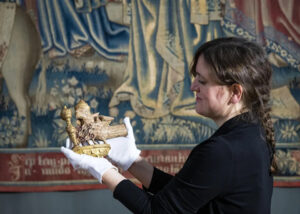 Thank you to Historic Royal Palace’s Press Office for sending me a press release about the newly discovered Anne Boleyn falcon badge being put on display from today at Hampton Court Palace. The following article is based on the release.
Thank you to Historic Royal Palace’s Press Office for sending me a press release about the newly discovered Anne Boleyn falcon badge being put on display from today at Hampton Court Palace. The following article is based on the release.
4th March 2022 is, of course, the 500th anniversary of Anne Boleyn’s first recorded appearance at the English court, following her return from France. New research has linked the badge to Hampton Court Palace’s Great Hall, so the badge has gone back home.
On this day in 1522, Shrove Tuesday, Anne Boleyn took part in the pageant of “The Château Vert” at York Place, a property owned by Cardinal Thomas Wolsey. The pageant was part of the Shrovetide celebrations which began on 1st March 1522 and which also celebrated the negotiations between Charles V, Holy Roman Emperor, and Henry VIII for a joint attack on France, which were to be sealed by the marriage of Charles V and Princess Mary, daughter of Henry VIII.
Anne played the part of Perseverance in a lavish pageant – read a contemporary account of the pageant, which included an assault on a castle and food throwing! – click here.
Anne’s heraldic badge is on display right now at Hampton Court, where experts believe it to have once formed part of the building’s famous interiors.
As you probably know from previous articles, the badge was discovered by antiques expert Paul Fitzsimmons – who recognised it as the symbol of Anne Boleyn – the blackened oak carving of a crowned falcon atop a tree stump flowering with Tudor roses was covered in centuries of soot, grime and wax. Following conservation, which saw the removal of a layer of black paint to reveal the original colouring of white, gold and red, it was brought to the attention of Tracy Borman, Joint Chief Curator at Historic Royal Palaces, by Sandra Vasoli, who had been corresponding with Paul, and her friend, James Peacock, who works at Hampton Court. It was taken to Hampton Court Palace for further investigation.
Having carefully examined the piece, curators at Historic Royal Palaces turned to original accounts of Henry VIII’s work to enlarge and embellish Hampton Court, and to comparing the find with remaining detailing from the period, in an attempt to shed light on the falcon’s origins. This work has revealed an incredible likeness in both size and design to the 43 surviving falcon badges decorating the ‘frieze’ above the windows and hammer beams in the palace’s Great Hall, leading them to believe that the carving is an element of the room’s original Tudor scheme.
The roof of the great hall is the last great medieval hammerbeam-roof in England, and carpenters were put to work on it following Henry VIII’s marriage to Anne Boleyn, adding motifs relating to her. Her coat of arms, the entwined letters H and A and her heraldic badge were all added to the hall’s decoration. Records for the works show that a Michael Joyner was paid £5 4s 2d for 250 ‘of the King’s and Queens badges standing upon the Caters within the said Hall at v[5]d the piece’.
Following Anne’s fall in 1536 and the king’s marriage to Jane Seymour, two craftsmen (John Heath and Henry Blankston) were employed to repaint and adapt Hampton Court’s existing decorative scheme. It is at this point curators now believe that the white falcons were overpainted in black, thereby severing their visual association with the former Queen.
Anne had begun using the white falcon (a device used by her paternal grandmother’s family, the Earls of Ormond) as her device around the time she was created Marquess of Pembroke, shortly before her public marriage to Henry VIII in 1533. After her marriage and coronation a new imperial falcon badge was created, featuring the crown and sceptre. This new symbol, complete with its Tudor and York roses growing from a dead tree stump has been read as symbolising the fertility of the new queen at the time of her marriage, and Anne’s aspiration to wear the imperial crown which Henry offered at the time of his break with the Catholic Church.
Sebastian Edwards, Deputy Chief Curator at Historic Royal Palaces, said: “Ever since my colleague Tracy Borman first flagged the carved falcon badge as a discovery meriting further investigation, it’s been a tantalising historic ‘what if?’. While we won’t be able to say for certain whether it was originally created for Hampton Court’s Great Hall until the next time we erect a roof-height scaffold and compare it with those still in situ – which might not be for some years – the evidence that has emerged during our research lends great weight to the theory, particularly with there being one falcon less than we’d expect in the surviving decorative scheme! Either way, this is an incredibly rare example of Tudor royal ornamentation, imbued with the legend of Henry’s most famous Queen, which I hope will provide visitors to Hampton Court with a small taste of the jaw-dropping magnificence of the palace during the Tudor period.”
Anne Boleyn’s falcon will be on display in the Great Hall at Hampton Court Palace from 4 March 2022 and is included in palace admission. Find out more about visiting the palace at https://www.hrp.org.uk/hampton-court-palace/#gs.sahcfq
Here is my interview with James Peacock and Sandra Vasoli about the falcon badge: